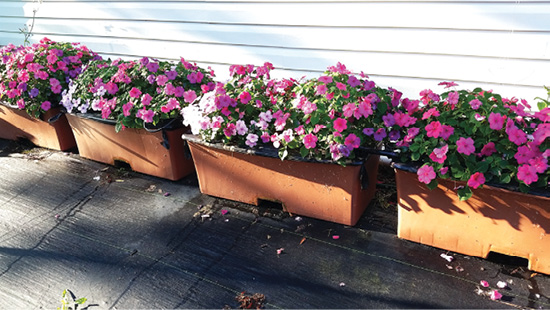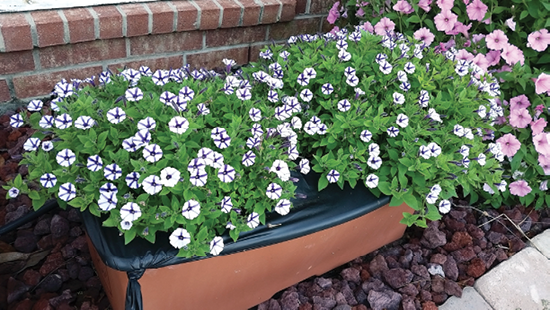Subirrigated Containers for the Mississippi Gardener

The interest in planting home gardens to grow fresh produce is increasing at a rapid pace; however, gardeners with limited growing space may find vegetable production to be challenging. Growing vegetables in containers is becoming a popular method for dealing with this problem, but the containers present their own unique challenges, especially in regard to watering.
Subirrigated containers offer a successful gardening alternative for gardeners with limited space—small yards, porches, or even balconies. While this publication primarily addresses vegetable gardening, subirrigated containers also do a good job at growing flowering ornamentals.
Subirrigated Containers
A subirrigated system contains a well in the bottom of the container to hold water, which is wicked up for the plant. This system creates the conditions for consistent moisture in the root zone. These containers are available for purchase, but handy gardeners can find do-it-yourself plans. In addition to small containers for homeowners, there are bigger subirrigated systems for commercial growers.
Growing Medium
To grow plants successfully in containers, the growing medium has to drain adequately while retaining enough moisture for the plant roots to access.
The recommended growing medium is called a “soilless mix” and contains various ratios of peat moss, pine bark, coir (coconut fiber), vermiculite, and perlite. These are the same components used in the greenhouse and nursery industry.
Premixed growing media come in a variety of package sizes—from 1-cubic-foot bags to 3.8-cubic-foot compressed bales that expand to 7 cubic feet. These commercial premixed growth media are formulated to have the characteristics to meet the growing needs of most plants. There are many commercially available brands of container media that are suitable for use in subirrigated containers.
These mixes also have additional amendments of controlled-release fertilizer, micronutrients, and dolomitic limestone. Wetting agents are commonly added to increase wettability, which is a positive attribute for growing media used in subirrigated containers. Some growing media formulations include fungicides and mycorrhizal fungi for promoting growth.

While it may seem like a cost saving, it’s important not to use native soil or commercial bagged media intended for amending in-ground planting beds. The physical characteristics of these materials (porosity, aeration, and water-holding capacity) are absolutely inappropriate for use in subirrigated containers.
When using peat-based soilless growing media, it’s not necessary to replace it every year. In fact, the same growing mix can be used in subirrigated containers for many years with just a little replenishment of new media each year. The physical characteristics of peat-based growing media prevent many soil-borne problems that occur when growing in traditional in-ground beds.
Watering
A subirrigated container has a water reservoir in the bottom. Potting media pull in the moisture in much the same way a sponge pulls liquid from a pan of water. This process is called capillary action. Water moves up into the root zone for the plants to access.
The container also contains a water overflow mechanism, which works in much the same way as the overflow in a bathroom sink. So, the subirrigated container cannot be overwatered.
Even though there is a water reservoir, the plants in subirrigated containers still need to be watered with the same frequency as plants grown in traditional containers. The main difference between these two types of containers is the method in which plants access moisture.

Common commercially available growing media suitable for use in subirrigated containers.
- Premier Horticulture Pro-Mix BX
- Premier Horticulture Pro-Mix Ultimate Organic Mix
- Espoma Organic Potting Mix
- Fox Farm Happy Frog Potting Soil
- Jungle Growth Flower & Vegetable Professional Mix
- Jungle Growth Pure Organic Potting Mix
- Scott’s Miracle-Gro Potting Mix
- Scott’s Miracle-Gro Organic Choice Potting Mix
- Scott’s Miracle-Gro Moisture Control Potting Mix
- Fafard All-Purpose Potting Mix
- Fafard Container Mix
- Baccto Professional Planting Mix
- Baccto Lite Premium Potting Soil
- Ferti-lome Ultimate Potting Mix
- Sun Gro Horticulture Metro Mix Potting Medium
- Sunshine Container Potting Mix
List not all inclusive.

If the subirrigated container’s reservoir is allowed to dry out, the capillary action of water will stop. It’s important to fill the reservoir each day to ensure the constant upward flow of water.
Many subirrigated containers also use covers over the growing media. While not required, this cover creates a barrier that blocks the evaporation of water from the potting medium surface, much like a layer of mulch. The only water lost is the amount transpired by the plant. Placing a cover on a subirrigated container makes water usage very efficient.
The cover also provides other benefits, such as virtually eliminating the need to remove weeds. It also protects the placement of fertilizer as described in the next section.

Fertilization

Growing plants in subirrigated containers requires the addition of dolomitic or calcitic garden lime. Peat-based growing media tend to have a lower pH than recommended, and they can be deficient in calcium and magnesium. Mix 1 cup of lime per cubic foot of growing medium before planting. You can use either pulverized or pelletized material. If you use pulverized lime, be sure to wear a dust mask to avoid inhalation because the material is so finely ground.

All plants need adequate fertilizer to achieve optimum growth. Many gardeners like to use water-soluble fertilizer as part of their normal irrigation for in-ground plants.
However, we don’t recommend adding water-soluble fertilizer to the subirrigated container reservoir. This method could lead to increased soluble salt levels in the reservoir that “burn” the plants roots and have a detrimental effect on plant growth.

We recommend placing granular fertilizer in a narrow band on top of the growing medium in a subirrigated container. As water is drawn upward, the fertilizer is continuously and slowly released for the growing season. Never mix the fertilizer with the potting medium, as it could cause the nutrients to be released too quickly and injure the plant roots.
General application rates would be about ½ pound (approximately 1 cup) of 5-5-5, 8-8-8, or 10-10-10 fertilizer per cubic foot of growing medium. Use organic granular fertilizer at a rate of 1 pound per cubic foot of growing medium.
Controlled-release, or slow-release, fertilizer also could be used. Apply it in the same quantities recommended for granular fertilizer.
As with in-ground plantings, side dressing is recommended for subirrigated containers during periods when the plants need supplemental fertilization, especially for heavy-feeding plants like tomatoes. Fertilizer applied in the band described previously usually will not provide enough nutrition throughout the entire growing season.
Calcium nitrate is the best choice for this supplemental fertilization. It supplies the extra nitrogen needed, as well as some calcium to help prevent blossom end rot. The readily available calcium is also beneficial during periods of active plant growth. The usual application rate is 1 teaspoon added directly to the reservoir through the irrigation tube. This is equivalent to side-dressing recommendations for in-ground plants.
Two Southern Gardening video demonstrations are available for those who want more information on setting up subirrigated containers. “Subirrigated Containers” can be found at http://extension.msstate.edu/southern-gardening/video/2014/sub-irrigated-containers. A longer, more in-depth version from Gardening Through the Seasons titled “Self-Irrigated Containers” can be found at https://www.youtube.com/watch?v=XpTnMa9S5vQ&feature=youtu.be&list=PL0075266F08A5BCB5. These videos, produced by the Mississippi State University Extension Service, are designed to provide seasonal tips, techniques, and how-to information for the home gardener.
Resource
The information given here is for educational purposes only. References to commercial products, trade names, or suppliers are made with the understanding that no endorsement is implied and that no discrimination against other products or suppliers is intended.
Publication 2971 (POD-10-22)
By Gary R. Bachman, PhD, Extension/Research Professor, Coastal Research and Extension Center, and Christine E.H. Coker, PhD, Extension/Research Professor, Coastal Research and Extension Center.
The Mississippi State University Extension Service is working to ensure all web content is accessible to all users. If you need assistance accessing any of our content, please email the webteam or call 662-325-2262.


